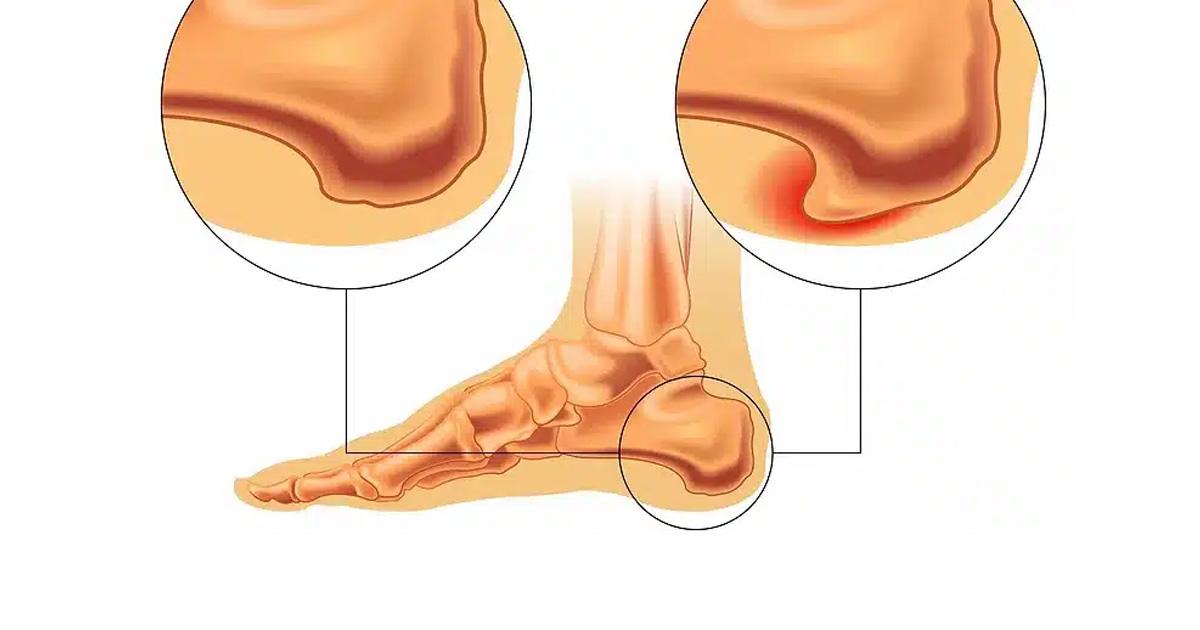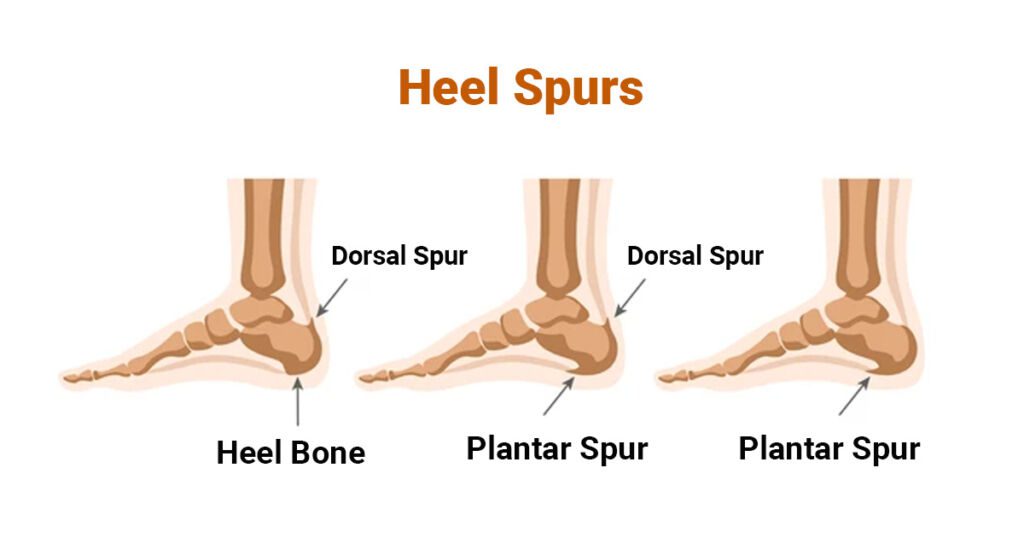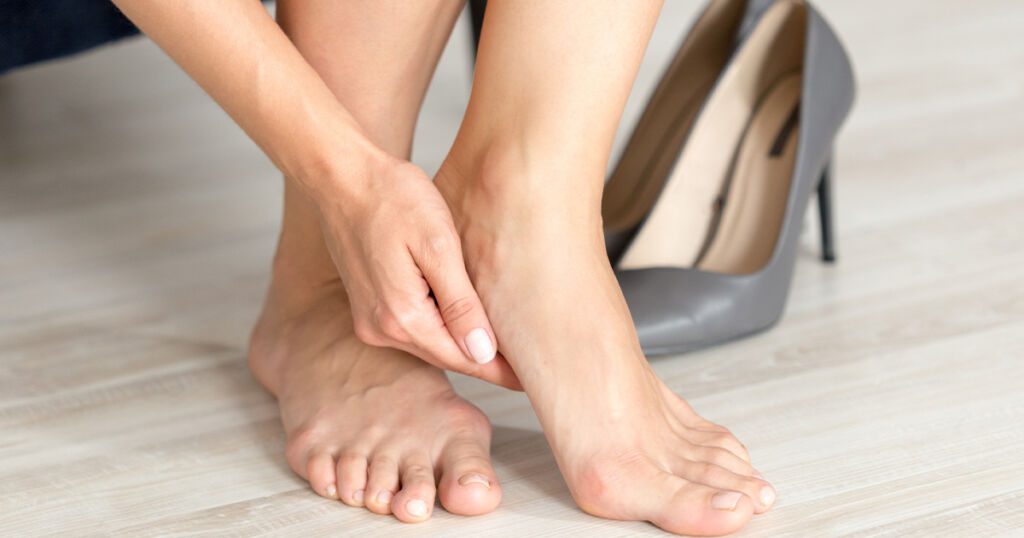
A heel spur, or calcaneal spur, is a bony growth of calcium deposits on the back or bottom of the heel bone that often has a hooked, pointy, or shelf-like shape.
Heel spurs develop over time when repeated strain or pressure damages the foot. This can cause an inflamed tendon or ligament to attach to the heel bone. While not everyone with a heel spur experiences symptoms, many people feel sharp pain, especially when walking or standing.
About 15% of people have heel spurs. They are most common in older adults, those with plantar fasciitis (inflammation of the heel tissue), and people living with obesity.
Types of Heel Spur, or Calcaneal spur
Healthcare providers categorize heel spurs based on where they form near your heel bone.
Plantar Heel Spur
A plantar heel spur forms on the bottom of the heel, where the plantar fascia ligament attaches to the heel bone. Inflammation of the plantar fascia (medically known as plantar fasciitis) can cause calcium deposits to build up on the bottom of your heel and form a plantar heel spur.
Dorsal Heel Spur
A dorsal heel spur appears on the back of the heel, near the point where the Achilles tendon connects to the heel bone. Inflammation of the Achilles tendon can cause calcium deposits to build up on the back of the heel.

Heel Spur Symptoms
Not all heel spurs cause noticeable symptoms. When symptoms appear, they are usually caused by inflammation in the tissues around the heel, not the spur itself. In some cases, the inflamed tissues can press on a nerve in the heel, leading to numbness, burning, or tingling.
The main symptom of a heel spur is heel pain, which often feels like a sharp, stabbing sensation at the bottom or back of the heel. The pain is usually worse when you take your first steps in the morning or after resting for a long time. It can also flare up after physical activity.
What Causes A Heel Spur?
Repeated stress on your heel—from activities like walking, running, or standing on hard surfaces for long periods—can damage the ligaments and tendons in your feet. As your body tries to heal this damage, inflammation can occur. Over time, small tears (microtears) in the tissue can lead to a buildup of calcium, causing irritation and pain.
How Physiotherapy Helps in Bone Heel Spur
Physiotherapy offers a well-rounded approach to managing heel spurs. It includes pain relief methods, stretching and strengthening exercises, gait training, and education. By targeting the root causes and creating personalized treatment plans, physiotherapy can greatly help those who are dealing with heel spurs.
Here’s a breakdown of how physiotherapy helps manage heel spurs:
- Education and Footwear Advice: You’ll receive guidance on choosing the right footwear and modifying activities to prevent further heel strain.
- Pain Relief: Techniques like ultrasound, TENS (Transcutaneous Electrical Nerve Stimulation), and ice therapy are used to reduce pain and inflammation.
- Stretching Exercises: Specific stretches for the plantar fascia and calf muscles help ease tension and improve flexibility.
- Strengthening Exercises: Strengthening the muscles in the foot and ankle provides better support and reduces strain on the heel.
- Gait Training: Physiotherapists analyze and adjust your walking pattern to minimize stress on the heel. They may also recommend custom orthotics for extra support.

How To Prevent Heel Spurs
It’s not always possible to prevent a heel spur. But, prevention strategies often look similar to at-home treatment options. To reduce your risk of developing heel spurs:
- Stretch your calf muscles and plantar fascia regularly
- Wear supportive footwear
- Warm up before you exercise
- Massage your feet, especially if you are on your feet for long periods
Frequently Asked Questions
What’s the difference between a heel spur and plantar fasciitis?
Plantar fasciitis is inflammation of the plantar fascia ligament, while a heel spur sticks out on the heel bone in response to inflammation or injury of the ligaments and tissues in the foot. Plantar fasciitis is one of the most common causes of heel spurs.
What happens if a heel spur goes untreated?
Untreated heel spurs can lead to chronic pain that can limit mobility and affect daily life. A heel spur can also irritate the soft tissues surrounding the bony growth, causing further inflammation and pain.
Is walking good for heel spurs?
Taking your first steps in the morning may be painful with a heel spur, especially one that develops due to plantar fasciitis.
Walking while wearing supportive shoes with heel cushioning may help reduce your pain. Avoid activities that aggravate your pain or place heavy demands on your foot and opt for low-impact exercises like swimming or cycling if walking is too uncomfortable.
